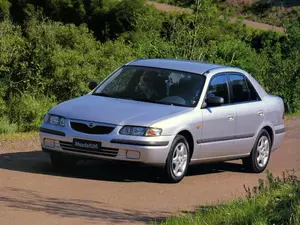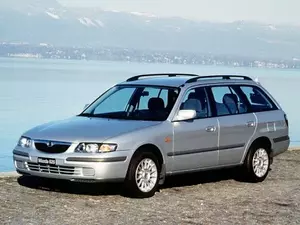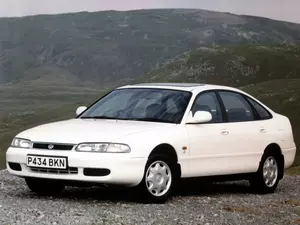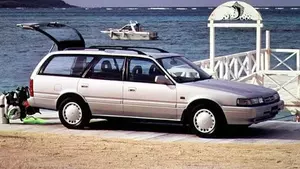
| Vehicle | Precise engine size | Difference from world average | Engine size to consumption ratio | Horsepower from 1 L | Engine size to 100 kg of weight |
|---|---|---|---|---|---|
| 1.9 |
1.84 L (1840 cc) |
21.6% smaller | - | 49 hp from 1 L | 153 cc to 100 kg |
| 2.0 |
1.99 L (1991 cc) |
15.1% smaller | - | 68 hp from 1 L | 153 cc to 100 kg |
| 2.0 Turbo DI |
2 L (1998 cc) |
14.8% smaller | 46 cc to 1 mpg | 51 hp from 1 L | 154 cc to 100 kg |
| 2.5 V6 |
2.5 L (2497 cc) |
6.4% bigger | - | 67 hp from 1 L | 178 cc to 100 kg |
| Vehicle | 1.9 |
|---|---|
| Precise engine size | 1.84 L (1840 cc) |
| Difference from world average | 21.6 smaller |
| Engine size to consumption ratio | - |
| Horsepower from 1 L | 49 hp from 1 L |
| Engine size to 100 kg of weight | 153 cc to 100 kg |
| Vehicle | 2.0 |
| Precise engine size | 1.99 L (1991 cc) |
| Difference from world average | 15.1 smaller |
| Engine size to consumption ratio | - |
| Horsepower from 1 L | 68 hp from 1 L |
| Engine size to 100 kg of weight | 153 cc to 100 kg |
| Vehicle | 2.0 Turbo DI |
| Precise engine size | 2 L (1998 cc) |
| Difference from world average | 14.8 smaller |
| Engine size to consumption ratio | 46 cc to 1 mpg |
| Horsepower from 1 L | 51 hp from 1 L |
| Engine size to 100 kg of weight | 154 cc to 100 kg |
| Vehicle | 2.5 V6 |
| Precise engine size | 2.5 L (2497 cc) |
| Difference from world average | 6.4 bigger |
| Engine size to consumption ratio | - |
| Horsepower from 1 L | 67 hp from 1 L |
| Engine size to 100 kg of weight | 178 cc to 100 kg |

| Vehicle | Precise engine size | Difference from world average | Engine size to consumption ratio | Horsepower from 1 L | Engine size to 100 kg of weight |
|---|---|---|---|---|---|
| 1.9 |
1.84 L (1840 cc) |
21.6% smaller | - | 49 hp from 1 L | 142 cc to 100 kg |
| 2.0 |
1.99 L (1991 cc) |
15.1% smaller | - | 58 hp from 1 L | 153 cc to 100 kg |
| 2.0 Turbo DI |
2 L (1998 cc) |
14.8% smaller | 46 cc to 1 mpg | 51 hp from 1 L | 143 cc to 100 kg |
| 2.0 H.P. |
1.99 L (1991 cc) |
15.1% smaller | - | 68 hp from 1 L | 153 cc to 100 kg |
| Vehicle | 1.9 |
|---|---|
| Precise engine size | 1.84 L (1840 cc) |
| Difference from world average | 21.6 smaller |
| Engine size to consumption ratio | - |
| Horsepower from 1 L | 49 hp from 1 L |
| Engine size to 100 kg of weight | 142 cc to 100 kg |
| Vehicle | 2.0 |
| Precise engine size | 1.99 L (1991 cc) |
| Difference from world average | 15.1 smaller |
| Engine size to consumption ratio | - |
| Horsepower from 1 L | 58 hp from 1 L |
| Engine size to 100 kg of weight | 153 cc to 100 kg |
| Vehicle | 2.0 Turbo DI |
| Precise engine size | 2 L (1998 cc) |
| Difference from world average | 14.8 smaller |
| Engine size to consumption ratio | 46 cc to 1 mpg |
| Horsepower from 1 L | 51 hp from 1 L |
| Engine size to 100 kg of weight | 143 cc to 100 kg |
| Vehicle | 2.0 H.P. |
| Precise engine size | 1.99 L (1991 cc) |
| Difference from world average | 15.1 smaller |
| Engine size to consumption ratio | - |
| Horsepower from 1 L | 68 hp from 1 L |
| Engine size to 100 kg of weight | 153 cc to 100 kg |

| Vehicle | Precise engine size | Difference from world average | Engine size to consumption ratio | Horsepower from 1 L | Engine size to 100 kg of weight |
|---|---|---|---|---|---|
| 1.9 |
1.84 L (1840 cc) |
21.6% smaller | - | 49 hp from 1 L | 153 cc to 100 kg |
| 2.0 |
1.99 L (1991 cc) |
15.1% smaller | - | 68 hp from 1 L | 153 cc to 100 kg |
| 2.0 |
1.99 L (1991 cc) |
15.1% smaller | - | 58 hp from 1 L | 166 cc to 100 kg |
| 2.0 Turbo DI |
2 L (1998 cc) |
14.8% smaller | 46 cc to 1 mpg | 51 hp from 1 L | 154 cc to 100 kg |
| Vehicle | 1.9 |
|---|---|
| Precise engine size | 1.84 L (1840 cc) |
| Difference from world average | 21.6 smaller |
| Engine size to consumption ratio | - |
| Horsepower from 1 L | 49 hp from 1 L |
| Engine size to 100 kg of weight | 153 cc to 100 kg |
| Vehicle | 2.0 |
| Precise engine size | 1.99 L (1991 cc) |
| Difference from world average | 15.1 smaller |
| Engine size to consumption ratio | - |
| Horsepower from 1 L | 68 hp from 1 L |
| Engine size to 100 kg of weight | 153 cc to 100 kg |
| Vehicle | 2.0 |
| Precise engine size | 1.99 L (1991 cc) |
| Difference from world average | 15.1 smaller |
| Engine size to consumption ratio | - |
| Horsepower from 1 L | 58 hp from 1 L |
| Engine size to 100 kg of weight | 166 cc to 100 kg |
| Vehicle | 2.0 Turbo DI |
| Precise engine size | 2 L (1998 cc) |
| Difference from world average | 14.8 smaller |
| Engine size to consumption ratio | 46 cc to 1 mpg |
| Horsepower from 1 L | 51 hp from 1 L |
| Engine size to 100 kg of weight | 154 cc to 100 kg |

| Vehicle | Precise engine size | Difference from world average | Engine size to consumption ratio | Horsepower from 1 L | Engine size to 100 kg of weight |
|---|---|---|---|---|---|
| 1.8 |
1.84 L (1840 cc) |
21.6% smaller | - | 49 hp from 1 L | - |
| 2.0i |
1.99 L (1991 cc) |
15.1% smaller | 66 cc to 1 mpg | 58 hp from 1 L | 166 cc to 100 kg |
| 2.0 D GLX Comprex |
2 L (1998 cc) |
14.8% smaller | 57 cc to 1 mpg | 38 hp from 1 L | 154 cc to 100 kg |
| 2.5 24V |
2.5 L (2497 cc) |
6.4% bigger | 100 cc to 1 mpg | 66 hp from 1 L | 192 cc to 100 kg |
| Vehicle | 1.8 |
|---|---|
| Precise engine size | 1.84 L (1840 cc) |
| Difference from world average | 21.6 smaller |
| Engine size to consumption ratio | - |
| Horsepower from 1 L | 49 hp from 1 L |
| Engine size to 100 kg of weight | - |
| Vehicle | 2.0i |
| Precise engine size | 1.99 L (1991 cc) |
| Difference from world average | 15.1 smaller |
| Engine size to consumption ratio | 66 cc to 1 mpg |
| Horsepower from 1 L | 58 hp from 1 L |
| Engine size to 100 kg of weight | 166 cc to 100 kg |
| Vehicle | 2.0 D GLX Comprex |
| Precise engine size | 2 L (1998 cc) |
| Difference from world average | 14.8 smaller |
| Engine size to consumption ratio | 57 cc to 1 mpg |
| Horsepower from 1 L | 38 hp from 1 L |
| Engine size to 100 kg of weight | 154 cc to 100 kg |
| Vehicle | 2.5 24V |
| Precise engine size | 2.5 L (2497 cc) |
| Difference from world average | 6.4 bigger |
| Engine size to consumption ratio | 100 cc to 1 mpg |
| Horsepower from 1 L | 66 hp from 1 L |
| Engine size to 100 kg of weight | 192 cc to 100 kg |

| Vehicle | Precise engine size | Difference from world average | Engine size to consumption ratio | Horsepower from 1 L | Engine size to 100 kg of weight |
|---|---|---|---|---|---|
| 2.0 D |
2 L (1998 cc) |
14.8% smaller | 57 cc to 1 mpg | 38 hp from 1 L | 154 cc to 100 kg |
| 2.0 i |
2 L (1998 cc) |
14.8% smaller | 71 cc to 1 mpg | 45 hp from 1 L | 167 cc to 100 kg |
| 2.2i |
2.18 L (2184 cc) |
6.9% smaller | 78 cc to 1 mpg | 53 hp from 1 L | 182 cc to 100 kg |
| Vehicle | 2.0 D |
|---|---|
| Precise engine size | 2 L (1998 cc) |
| Difference from world average | 14.8 smaller |
| Engine size to consumption ratio | 57 cc to 1 mpg |
| Horsepower from 1 L | 38 hp from 1 L |
| Engine size to 100 kg of weight | 154 cc to 100 kg |
| Vehicle | 2.0 i |
| Precise engine size | 2 L (1998 cc) |
| Difference from world average | 14.8 smaller |
| Engine size to consumption ratio | 71 cc to 1 mpg |
| Horsepower from 1 L | 45 hp from 1 L |
| Engine size to 100 kg of weight | 167 cc to 100 kg |
| Vehicle | 2.2i |
| Precise engine size | 2.18 L (2184 cc) |
| Difference from world average | 6.9 smaller |
| Engine size to consumption ratio | 78 cc to 1 mpg |
| Horsepower from 1 L | 53 hp from 1 L |
| Engine size to 100 kg of weight | 182 cc to 100 kg |

| Vehicle | Precise engine size | Difference from world average | Engine size to consumption ratio | Horsepower from 1 L | Engine size to 100 kg of weight |
|---|---|---|---|---|---|
| 1.8 i |
1.84 L (1840 cc) |
21.6% smaller | 66 cc to 1 mpg | 57 hp from 1 L | 153 cc to 100 kg |
| 2.0 D GLX Comprex |
2 L (1998 cc) |
14.8% smaller | 57 cc to 1 mpg | 38 hp from 1 L | 154 cc to 100 kg |
| 2.0i |
1.99 L (1991 cc) |
15.1% smaller | 69 cc to 1 mpg | 58 hp from 1 L | 166 cc to 100 kg |
| Vehicle | 1.8 i |
|---|---|
| Precise engine size | 1.84 L (1840 cc) |
| Difference from world average | 21.6 smaller |
| Engine size to consumption ratio | 66 cc to 1 mpg |
| Horsepower from 1 L | 57 hp from 1 L |
| Engine size to 100 kg of weight | 153 cc to 100 kg |
| Vehicle | 2.0 D GLX Comprex |
| Precise engine size | 2 L (1998 cc) |
| Difference from world average | 14.8 smaller |
| Engine size to consumption ratio | 57 cc to 1 mpg |
| Horsepower from 1 L | 38 hp from 1 L |
| Engine size to 100 kg of weight | 154 cc to 100 kg |
| Vehicle | 2.0i |
| Precise engine size | 1.99 L (1991 cc) |
| Difference from world average | 15.1 smaller |
| Engine size to consumption ratio | 69 cc to 1 mpg |
| Horsepower from 1 L | 58 hp from 1 L |
| Engine size to 100 kg of weight | 166 cc to 100 kg |

| Vehicle | Precise engine size | Difference from world average | Engine size to consumption ratio | Horsepower from 1 L | Engine size to 100 kg of weight |
|---|---|---|---|---|---|
| 2.0 12V |
2 L (1998 cc) |
14.8% smaller | - | 54 hp from 1 L | - |
| Vehicle | 2.0 12V |
|---|---|
| Precise engine size | 2 L (1998 cc) |
| Difference from world average | 14.8 smaller |
| Engine size to consumption ratio | - |
| Horsepower from 1 L | 54 hp from 1 L |
| Engine size to 100 kg of weight | - |

| Vehicle | Precise engine size | Difference from world average | Engine size to consumption ratio | Horsepower from 1 L | Engine size to 100 kg of weight |
|---|---|---|---|---|---|
| 2.0 12V |
2 L (2000 cc) |
14.7% smaller | - | 54 hp from 1 L | - |
| 2.0 D |
2 L (1998 cc) |
14.8% smaller | 51 cc to 1 mpg | 30 hp from 1 L | - |
| Vehicle | 2.0 12V |
|---|---|
| Precise engine size | 2 L (2000 cc) |
| Difference from world average | 14.7 smaller |
| Engine size to consumption ratio | - |
| Horsepower from 1 L | 54 hp from 1 L |
| Engine size to 100 kg of weight | - |
| Vehicle | 2.0 D |
| Precise engine size | 2 L (1998 cc) |
| Difference from world average | 14.8 smaller |
| Engine size to consumption ratio | 51 cc to 1 mpg |
| Horsepower from 1 L | 30 hp from 1 L |
| Engine size to 100 kg of weight | - |

| Vehicle | Precise engine size | Difference from world average | Engine size to consumption ratio | Horsepower from 1 L | Engine size to 100 kg of weight |
|---|---|---|---|---|---|
| 2.0 |
2 L (1998 cc) |
14.8% smaller | - | 45 hp from 1 L | - |
| Vehicle | 2.0 |
|---|---|
| Precise engine size | 2 L (1998 cc) |
| Difference from world average | 14.8 smaller |
| Engine size to consumption ratio | - |
| Horsepower from 1 L | 45 hp from 1 L |
| Engine size to 100 kg of weight | - |

| Vehicle | Precise engine size | Difference from world average | Engine size to consumption ratio | Horsepower from 1 L | Engine size to 100 kg of weight |
|---|---|---|---|---|---|
| 2.0 |
2 L (1998 cc) |
14.8% smaller | 74 cc to 1 mpg | 51 hp from 1 L | 167 cc to 100 kg |
| Vehicle | 2.0 |
|---|---|
| Precise engine size | 2 L (1998 cc) |
| Difference from world average | 14.8 smaller |
| Engine size to consumption ratio | 74 cc to 1 mpg |
| Horsepower from 1 L | 51 hp from 1 L |
| Engine size to 100 kg of weight | 167 cc to 100 kg |